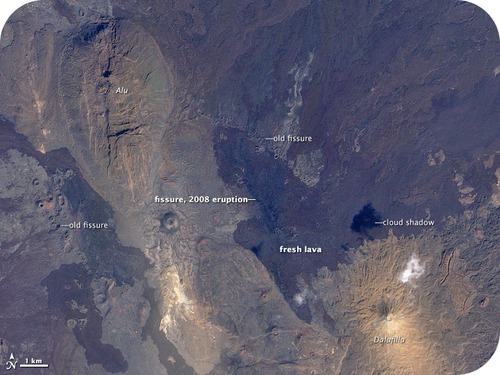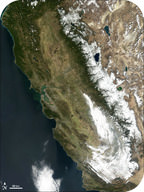16.8中生代板块构造
章节大纲
-
Why would a supercontinent break up?
::为什么超级大陆分崩离析?A continent is like a giant blanket that traps heat . Heat from the mantle comes up but cannot escape through the continent. This image shows hot material beneath New Mexico. The heat is trapped beneath the North American plate . The hot material is causing rifting to begin. This is known as the Rio Grande Rift.
::大陆就像一个巨型的毯子,它捕捉热。 地壳的热能上升, 却无法穿过大陆。 这个图像显示在新墨西哥州下面的热材料。 热能被困在北美板块下面。 热能材料正在引发裂痕。 这被称为里奥格兰德裂谷 。Supercontinent Breakup
::超级内分泌分裂Why would a supercontinent break up? Remember that is hot. Heat builds up beneath the supercontinent. This causes the continent to buoy upward. Continental rifting begins. Basalt lava fills in the rift. This could lead to seafloor spreading and the formation of a new ocean basin . This basalt province is where Africa is splitting apart and generating basalt lava. ( Figure )
::为何超级大陆分崩离析? 记得那很热吗? 热热在超大陆下积聚热量, 这导致大陆向上浮。 大陆裂开开始。 巴萨尔特熔岩填满裂口, 可能导致海底扩张和形成一个新的海洋盆地。 这个巴萨尔特省是非洲分裂并产生岩浆的地方。 (图 )In the Afar Region of Ethiopia, Africa is splitting apart. Three plates are pulling away from a central point. The Breakup of Pangaea
::邦加埃亚的分裂At the end of the Paleozoic, Earth’s landmasses were all part of one supercontinent called Pangea, which was surrounded by a single ocean, Panthalassa. Pangaea began to break apart at the end of the Triassic Period, about 200 million years ago. The Panthalassa Ocean separated into the individual but interconnected oceans that we see today on Earth.
::帕利奥索伊克河的尽头,地球的陆地资产都是一个叫做潘热亚的超级大陆的一部分。 潘热亚环绕着一个海洋,潘塔拉萨。 潘加亚在大约两亿年前的三亚西克河时期结束时开始分裂。 潘加拉萨海与我们今天在地球上看到的单个但相互联系的海洋相隔绝。Continental rifting and then seafloor spreading pushed Africa and South America apart. The Atlantic Ocean basin formed in between the continents. Seafloor spreading continues to enlarge the Atlantic Ocean today.
::大陆裂痕,然后海底扩张,将非洲和南美洲分开,大西洋海盆在大陆之间形成,海床扩张今天继续扩大大西洋。Growth of Continents
::非洲大陆的增长The moving continents collided with island arcs and microcontinents . Mountain ranges grew near the continents’ edges. The oceanic Farallon plate subducted beneath western North America during the late Jurassic and early Cretaceous. This activity produced igneous intrusions and other structures. The intrusions have since been uplifted. They are exposed in the Sierra Nevada Mountains ( Figure ).
::移动的大陆与岛屿弧和微大陆相撞。 山脉在大陆边缘附近增长。 远洋法拉隆板块在已故的侏罗纪和早期白鲸时期被从北美西部稀释下来。 这一活动产生了令人发指的入侵和其他结构。 入侵从那时起就被提升了。 它们暴露在内华达山(Figure ) 。The snow-covered Sierra Nevada is seen striking SE to NW across the eastern third of the image. The mountain range is a line of uplifted batholiths from Mesozoic subduction. Summary
::摘要- Continents keep mantle heat from escaping. This may eventually lead to continental rifting.
::大陆防止地壳热量逃逸,这最终可能导致大陆裂开。
- Continents grow as microcontinents or igneous activity add continental crust to an existing continent.
::大陆成长为微毗连或微弱活动,将大陆地壳添加到现有大陆。
- When a supercontinent breaks apart, new seafloor forms between the new continental masses.
::当超级大陆分崩离析时,新的海底形成于新的大陆块之间。
Review
::回顾- Is Pangaea still breaking up? Why or why not?
::潘加亚还在分手吗?
- How do continents grow?
::大陆是如何增长的?
- How did the Sierra Nevada mountains form?
::内华达山脉是如何形成的?
- Continents keep mantle heat from escaping. This may eventually lead to continental rifting.


